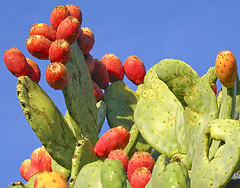Prickly pears
| Infobox on Prickly pears | |
|---|---|
| Example of Prickly pears |  |
| Freshness facts | |
| Optimum carrying temperature | 5°C to 8°C |
| Highest freezing point | - |
| Acceptable product temp. at loading into containers | Max. 2°C above carrying temperature |
| Optimum humidity | 90-95% |
| Ventilation setting for containers | 10 m³/hr |
| Storage life | 2 to 5 weeks |
| Climacteric / non-climacteric | Non-climacteric |
| Ethylene production | None |
| Ethylene sensitivity | Low |
| Modified / controlled atmosphere | 2%-5% CO2; 2% O2 |
| Potential benefits | Excellent |
| Availability | |
| South Africa South America |
November - February January - May |
Prickly pears
Contents
Harvesting and Handling
Prickly pear fruit are harvested from various species of the Prickly pear cactus. The fruit is a berry, and consists of a thick fleshy skin or rind surrounding a juicy pulp that contains many hard-coated seeds. Fruit vary considerably in colour, size and flavour.
Fruit of high quality need to be harvested near full-ripe to have colour and flavour typical of each variety. They should have a high percentage of pulp, a low content of seeds, and have a peel that is easy to remove. Stage of maturity or ripeness at harvest is very important for fruit quality since sugar content and sweetness do not increase after harvest. Maturity indices include: fruit size and fullness; change in peel colour, abscission of the small spines or glochids; fruit firmness; and flattening of the floral cavity or receptacle. Peel colour is the single most important index for commercial harvest.
Fruit are packed according to colour, size, and condition in single or double layer tray cartons. Large fruit may be wrapped in tissue paper to reduce scuffing and other physical injury. Fruit may also be packaged in cartons with perforated plastic liners to reduce water loss under dry storage conditions. Fruit can be bruised easily by finger compression during harvest, but damage to the stem-end is by far the most serious mechanical injury. High gloss fruit waxes are often used to improve visual appearance and reduce dehydration.
Cooling and Storage
Depending on variety, ripeness stage, and harvest season, fruit can be kept for 2 to 5 weeks at 5°C to 8°C with 90% to 95% RH. Factors limiting storage-life are decay, dehydration and chilling injury. Cactus pear fruit are especially chilling sensitive when stored at <5°C, but chilling injury may occur in some varieties at <10°C. Symptoms include pitting, surface bronzing and dark spots on the peel, and increased susceptibility to decay. Summer harvested fruit are more chilling sensitive than autumn-harvested fruit.
Mixed loads
Prickly pear fruit produce very low amounts of ethylene, and are not sensitive to ethylene exposure.
Cautions
Limited research indicates holding cactus pears at 5°C in 2% O2 and 2% to 5% CO2 delays ripening and extends storage life.
Storage disorders
Bacterial rots.











